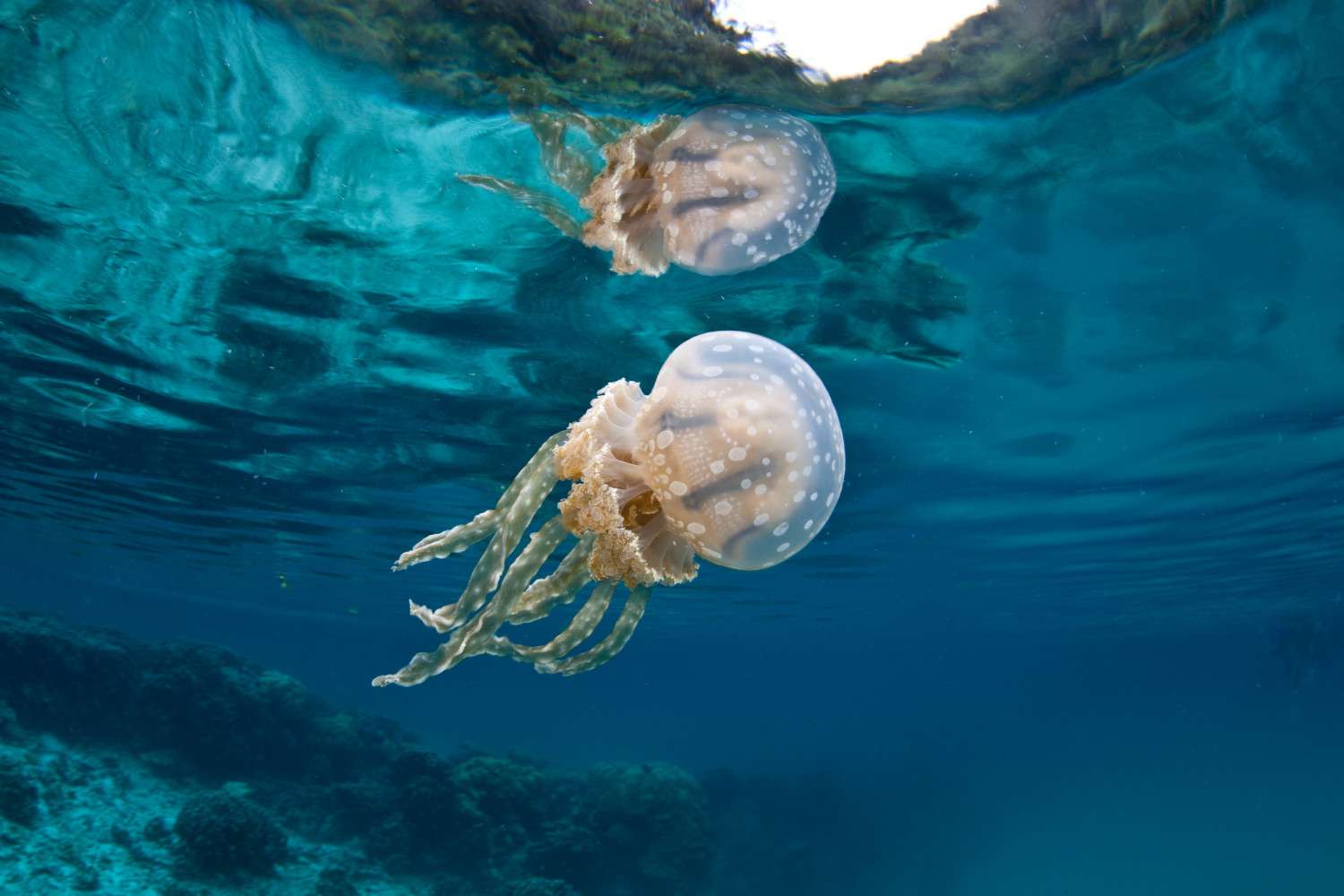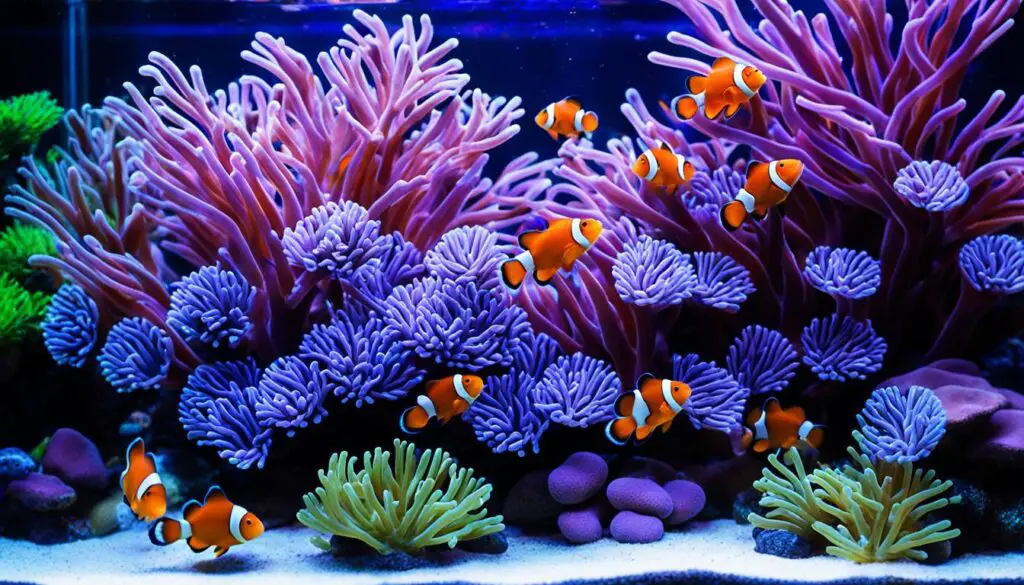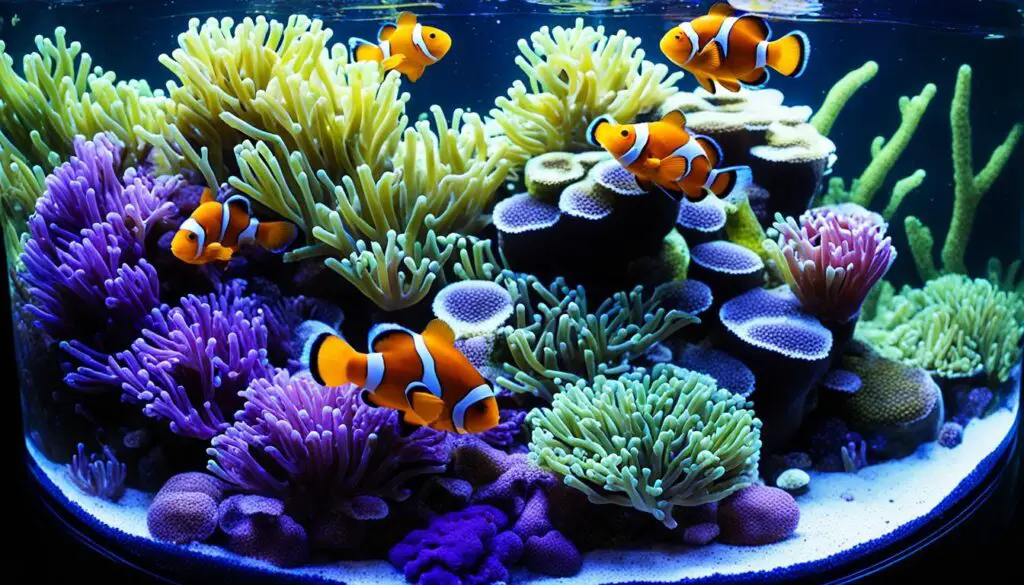What Brings Jellyfish To Shore

Introduction
What Brings Jellyfish To Shore: Jellyfish are captivating and mysterious creatures that inhabit the world’s oceans, known for their translucent bodies and graceful, undulating movements beneath the waves. Yet, there are times when these enigmatic sea dwellers venture closer to our shores, leaving us perplexed by the question: What brings jellyfish to the shore.
The phenomenon of jellyfish appearing on beaches has long intrigued scientists, beachgoers, and coastal communities. While jellyfish are marine animals that typically inhabit the open waters, they occasionally find themselves washed up on sandy shores. This occurrence, known as a jellyfish stranding event, can be a fascinating and sometimes alarming sight.
Understanding what draws jellyfish to the shore is essential for various reasons. First, it provides insights into the ecological dynamics of coastal ecosystems and how they are affected by environmental changes. Second, these strandings can have repercussions for both local biodiversity and human activities, as they may coincide with tourism seasons or influence fishing practices.

How do jellyfish come to shore?
According to Live Science, the reason why you sometimes find beached jellyfish is because they float with a rigid “sail” that pokes out of the water. While this often helps them travel and snag food, it sometimes blows full colonies ashore. Sadly, when this happens, the jellies die very quickly.
Jellyfish can often be found washed ashore due to a combination of factors, primarily driven by ocean currents, tides, and wind. These gelatinous creatures lack strong swimming capabilities and are at the mercy of the marine environment. Here’s how they end up on the shore:
1. Ocean Currents: Jellyfish are passive drifters, relying on ocean currents to move around. When these currents bring them close to the coast, there’s a higher likelihood of them being pushed ashore.
2. Tides: Rising and falling tides play a role in carrying jellyfish towards the shore. During high tide, they may be carried into shallow areas, increasing the chances of stranding.
3. Wind: Wind can influence the movement of jellyfish on the surface of the water. Strong winds can push them closer to the shore.
4. Temperature and Salinity: Changes in water temperature and salinity can also affect the distribution of jellyfish. They may be more prone to drifting towards the coast in certain conditions.
5. Weak Swimmers: Jellyfish are not strong swimmers and are easily carried by currents. As a result, they can end up closer to the shore even without any specific intention to do so.
Once on the shore, jellyfish may become stranded, unable to return to the water, which can be detrimental to their survival.
Why do jellyfish come so close to shore?
Writing about moon jellies, Carson explains that they head towards the shore near the end of their lives. They offer no resistance to the tidal currents, so each flood tide brings them onto the beach. Why would the jellies be okay with getting stranded on the beach? They’re carrying their young.
Jellyfish can often be found in close proximity to the shore due to a combination of ecological and environmental factors. One primary reason is that many jellyfish species are planktonic drifters, lacking the ability to swim against currents effectively. As a result, they are at the mercy of ocean currents, which can carry them towards the coast.
Another significant factor is the availability of food. Coastal areas can be rich in plankton and small fish, which are primary food sources for many jellyfish species. The proximity to these food sources makes it advantageous for jellyfish to venture closer to the shore in search of sustenance.
Additionally, water temperature and salinity gradients near the coast can influence jellyfish distribution. Some species are more tolerant of varying conditions, allowing them to adapt to the coastal environment.
While these factors bring jellyfish closer to the shore, changes in tides and wind patterns can play a role in pushing them onto the beach. It’s essential to understand that jellyfish movements are largely influenced by their environment, and their presence near the shore is a result of their unique ecological adaptations and the dynamic forces of the ocean.
Are jellyfish alive when they wash up on shore?
Jellyfish are mostly made of water, so they die quickly after washing onshore. They’re cold-blooded animals and can lose mobility when water temperatures are below normal.
When jellyfish wash up on the shore, their status as “alive” or “dead” can vary depending on the circumstances and how long they have been stranded. Jellyfish are indeed living organisms, but they lack a centralized nervous system and a well-defined brain, making them quite different from many other animals. They are composed of a gelatinous, translucent body with tentacles equipped for stinging prey.
If a jellyfish is freshly washed up on the shore, it might still be alive. Some species can survive brief periods out of the water, especially if the conditions are relatively moist and they are kept from drying out. In such cases, returning them to the water can potentially save their lives.
However, once a jellyfish is stranded on the shore for an extended period, exposure to the sun and air can lead to desiccation, causing them to lose water and eventually die. Some species may also be more resilient than others when it comes to surviving out of water. It’s essential to exercise caution when handling stranded jellyfish, as their tentacles may still contain stinging cells that can cause discomfort or injury.
While jellyfish are living creatures, their status when washed up on the shore depends on the duration of stranding, the specific species, and environmental conditions. Freshly stranded jellyfish may still be alive, but over time, they can deteriorate and ultimately die due to dehydration and exposure.
What to do with jellyfish on shore?
As with Portugese Man-of-Wars – watch along the beach for washed up ‘jellies’ before going swimming or wading. Don’t touch dead jellyfish lying on the beach – the stinging cells are probably still active. If you get stung, splash the area with salt water. Then apply a paste of unseasoned meat tenderizer.
Encountering stranded jellyfish on the shore raises questions about how to handle them safely and responsibly.
1. Observe from a Distance: Approach stranded jellyfish with caution. Keep a safe distance to avoid potential stings, as some species may still have active stinging cells in their tentacles. Do not touch them with bare hands.
2. Do Not Remove from the Water: If a jellyfish is freshly stranded and still appears alive, gently and carefully return it to the water. Use a flat, plastic object like a credit card or the edge of a shell to scoop it up and place it back in the sea. Ensure you’re not in contact with the tentacles.
3. Avoid Walking on Them: Be cautious not to step on or crush stranded jellyfish, as this can damage them and release stinging cells.
4. Be Mindful of Environmental Impact: Consider the environment and local regulations when handling jellyfish. Ensure your actions are respectful of the natural ecosystem.
5. Report Sightings: If you observe a large number of stranded jellyfish or unusual occurrences, consider reporting it to local marine or environmental authorities. This information can be valuable for research and conservation efforts.
6. First Aid for Stings: If someone is stung by a jellyfish, provide first aid as needed, which may involve rinsing the affected area with seawater, removing tentacles with a non-abrasive object, and seeking medical attention if the sting is severe or if an allergic reaction occurs.
The best approach when dealing with jellyfish on the shore is to respect their natural habitat, handle them with care if necessary, and prioritize safety for both yourself and the environment.
Can you touch a jellyfish on the shore?
If you surf or dive in the ocean, wear a protective bodysuit. Never touch a jellyfish that’s washed up on shore. Dead jellyfish still have venom in their tentacles that can sting on contact.
1. Stinging Tentacles: Many jellyfish species have specialized cells in their tentacles called nematocysts, which contain venom used for capturing prey and self-defense. Even when stranded, these nematocysts can remain active and capable of stinging upon contact. Touching a stranded jellyfish, even if it looks lifeless, can result in painful stings.
2. Species Variation: Different species of jellyfish have varying degrees of toxicity and stinging power. It’s difficult to visually identify the species when the jellyfish is on the shore, so it’s best to assume they could be potentially harmful.
3. Allergic Reactions: Stings from some jellyfish species can lead to allergic reactions or severe discomfort, and these can be triggered by even slight contact with the skin.
4. Environmental Concerns: Handling or disturbing stranded jellyfish can disrupt their natural habitat and contribute to their distress or death.
If you find a stranded jellyfish and need to move it, it’s advisable to do so with extreme caution. Use a flat, non-abrasive object like a plastic card, a shell, or a piece of driftwood to gently lift the jellyfish and return it to the water. Wearing gloves and protective clothing can also minimize the risk of stings. Always prioritize your safety and the welfare of the jellyfish and the environment when encountering these creatures on the shore.
What Brings Jellyfish To Shore?
Jellyfish are brought to shore by a combination of natural factors and environmental conditions. One of the primary factors is ocean currents. When strong currents push water towards the shore, they can carry jellyfish with them. Jellyfish are not strong swimmers, and they are largely at the mercy of the water’s movement.
Jellyfish are intriguing creatures that occasionally wash up on shorelines, prompting curiosity about what draws them to the land. Several factors contribute to this phenomenon. One primary reason is the influence of ocean currents and tides. Strong currents, wind patterns, and tides can carry jellyfish closer to the coast, ultimately depositing them on the beach. Additionally, environmental conditions, such as temperature and salinity changes, can affect jellyfish behavior. They may be disoriented by sudden shifts in water conditions and end up stranded.
Seasonal variations can play a role. Some species of jellyfish follow seasonal migration patterns, moving towards coastal areas during specific times of the year to reproduce. This natural life cycle can lead to their temporary presence on the shore. Human activities, like pollution and climate change, also impact jellyfish behavior. These factors may alter the distribution of their prey or create new opportunities for them to reach the shore. In some cases, jellyfish stranding can result from sheer coincidence, as they are at the mercy of their oceanic environment. The mystery of what brings jellyfish to shore continues to captivate marine biologists and beachgoers alike, highlighting the complex and interconnected nature of marine ecosystems.
What causes jellyfish to wash up on shore?
Jellyfish wash up on shore due to a combination of natural and environmental factors. One key factor is ocean currents. Strong winds and currents can push jellyfish closer to the coast, causing them to end up on the beach. Additionally, during certain times of the year, jellyfish may be more abundant near the shore due to their life cycle, and this can increase the chances of them being washed ashore.
Jellyfish washing up on shorelines is a fascinating natural occurrence influenced by various factors. Ocean currents and tides are among the primary drivers of this phenomenon. Strong currents, wind patterns, and tidal movements can carry jellyfish closer to the coast, eventually depositing them on the beach. These creatures, being largely at the mercy of their aquatic environment, may become stranded due to the ebb and flow of these forces.
Environmental conditions also play a significant role in jellyfish behavior. Sudden changes in temperature and salinity can disorient these gelatinous animals, causing them to drift towards the shore. Seasonal variations are another contributing factor. Some species of jellyfish follow specific seasonal migration patterns, moving closer to coastal areas during certain times of the year, often driven by the need to reproduce.
Human activities further complicate the picture. Pollution and climate change can disrupt the distribution of jellyfish prey, creating new opportunities for them to reach the shore. In some instances, jellyfish strandings may be a result of coincidence, where they inadvertently end up on the beach due to a confluence of these factors. The complex interplay of natural and human-induced factors keeps the mystery of jellyfish stranding alive, illustrating the intricate dynamics of marine ecosystems.
How do tides affect the presence of jellyfish on the shore?
Tides are another important factor in determining when and where jellyfish appear on the shore. During high tides, jellyfish are more likely to be carried closer to the coast. When the tide recedes, jellyfish can become stranded on the beach. Some species of jellyfish are more prone to stranding during specific tidal conditions.
Tides play a crucial role in influencing the presence of jellyfish on shorelines. The cyclical rise and fall of ocean water levels driven by the gravitational forces of the moon and the sun have a direct impact on the distribution and stranding of these gelatinous creatures.
During high tide, the ocean’s water level rises and pushes closer to the coast, carrying with it a variety of marine organisms, including jellyfish. As the tide recedes during low tide, the water retreats, often leaving behind stranded jellyfish on the shore. These stranded jellyfish may become beached or trapped in tidal pools, becoming a common sight for beachgoers.
The tidal cycles are not only about the vertical movement of water but also the horizontal motion. This back-and-forth movement can disorient and carry jellyfish from their preferred locations in deeper waters toward the shore.
Moreover, the frequency and timing of tides can affect the regularity of jellyfish strandings. Some coastal areas experience higher tides at specific times, leading to more frequent jellyfish appearances during certain phases of the lunar cycle.
Tides are a significant factor in the presence of jellyfish on the shore. Their ebb and flow create dynamic conditions that may lead to jellyfish stranding, making the timing and magnitude of tides an essential consideration for understanding this natural occurrence along coastal areas.

Conclusion
The mysterious phenomenon of jellyfish washing ashore has fascinated scientists and beachgoers alike. While there is no single, definitive answer to the question of what brings jellyfish to shore, several key factors have been identified.
First and foremost, ocean currents play a significant role in transporting jellyfish towards the shore. These currents can be influenced by a variety of natural and man-made factors, including wind patterns and climate change, which can affect water temperatures and salinity.
Jellyfish may be drawn to the shore by an abundance of food sources, such as small fish and plankton. This can lead to swarms of jellyfish congregating in coastal areas to feed.
Human activities, such as pollution and overfishing, have also been implicated in the increased occurrence of jellyfish strandings. These activities can disrupt marine ecosystems, creating imbalances that favor jellyfish proliferation.



